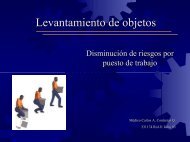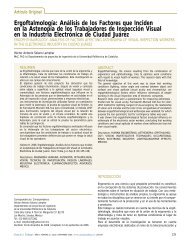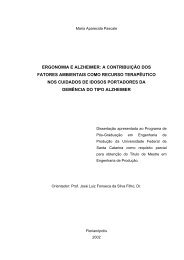Success Stories.12r5 - Human Factors and Ergonomics Society
Success Stories.12r5 - Human Factors and Ergonomics Society
Success Stories.12r5 - Human Factors and Ergonomics Society
Create successful ePaper yourself
Turn your PDF publications into a flip-book with our unique Google optimized e-Paper software.
ergonomics training program <strong>and</strong> related materials. A good example<br />
of what can happen when you couple collaborative managementlabor<br />
commitment with professional ergonomics.<br />
Deere <strong>and</strong> Company. One of the best-known successful industrial<br />
safety ergonomics programs is that at Deere <strong>and</strong> Company, the<br />
largest manufacturer of agricultural equipment in North America.<br />
In 1979, Deere recognized that traditional interventions like employee<br />
lift training <strong>and</strong> conservative medical management were, by<br />
themselves, insufficient to reduce injuries. So the company began to<br />
use ergonomics principles to redesign <strong>and</strong> reduce physical stresses<br />
of the job.<br />
Eventually, ergonomics coordinators were appointed in all<br />
of Deere’s U.S. <strong>and</strong> Canadian factories, foundries, <strong>and</strong> distribution<br />
centers. These coordinators, chosen from the industrial engineering<br />
<strong>and</strong> safety departments, were trained in ergonomics. Today, job<br />
evaluations <strong>and</strong> analyses are done in-house by both part-time<br />
ergonomics coordinators <strong>and</strong> wage-employee ergonomics teams <strong>and</strong><br />
committees. The company has developed its own ergonomics<br />
checklists <strong>and</strong> surveys. The program involves extensive employee<br />
participation.<br />
Since 1979, Deere has recorded an 83% reduction in incidence<br />
of back injuries, <strong>and</strong> by 1984 it had reduced workers compensation<br />
costs by 32%. According to Gary Lovestead, each year hundreds to<br />
thous<strong>and</strong>s of ergonomics improvements are implemented; <strong>and</strong><br />
today, ergonomics is built into Deere’s operating culture (Center for<br />
Workplace Health Information, 1995c).<br />
Coupler knuckle storage.<br />
Union Pacific Railroad. In the early 1980s, the Palestine<br />
Car Shop near Dallas, Texas, had the worst safety statistics of the<br />
Union Pacific Railroad’s shop operations. Of particular note was the<br />
high incidence of back injuries. For example, in 1985, 9 of 13 losttime<br />
injuries were back injuries, <strong>and</strong> 579 lost <strong>and</strong> 194 restricted or<br />
limited work days accumulated. Only 1,564 cars were repaired that<br />
year, <strong>and</strong> absenteeism was 4 percent (Association of American<br />
Railroads, 1989).<br />
The University of Michigan Center for <strong>Ergonomics</strong> computer<br />
model for back compression was modified <strong>and</strong> exp<strong>and</strong>ed for easy<br />
application to the railroad environment <strong>and</strong> packaged by the<br />
Association of American Railroads. The AAR-Back Model was<br />
introduced at the Palistine Car Shop to identify job tasks that<br />
exceeded acceptable back compression values, <strong>and</strong> equipment supporting<br />
various jobs requiring lifting was redesigned. For example, a<br />
coupler knuckle storage table was designed for storing the 90 lb.<br />
knuckles (see photo). Previously, they were manually piled on the<br />
ground <strong>and</strong> then lifted from there. In addition, a commercial back<br />
injury training program, Pro-Back, was adopted, <strong>and</strong> every employee<br />
was taught how to bend <strong>and</strong> lift safely. Finally, management attitude<br />
<strong>and</strong> priorities about safety were conveyed through weekly<br />
meetings with safety captains from each work area <strong>and</strong> quarterly<br />
“town hall” meetings with all shop employees.<br />
From 1985 to 1988, the total incidents of injuries went from 33 to<br />
12, back incidents from 13 to 0, lost days from 579 to 0, restricted days<br />
from 194 to 40 (all from minor, non-back injuries), <strong>and</strong> absenteeism<br />
11















